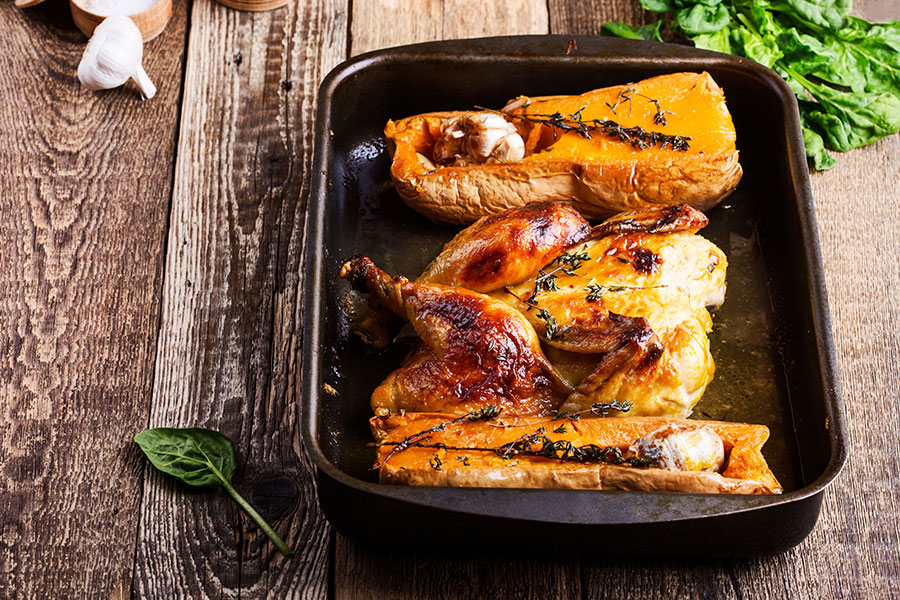Don’t be chicken
Try 5 new ways of cooking the boring bird for your diet.
Story: Constant Contact
If you’re losing weight then you already know it: chicken, especially the breast, is highly regarded for its high protein content compared to its low caloric impact. Maybe when you first started on your weight loss journey you embraced chicken, loved chicken, were excited about chicken! And now you’re just hoping there’s some hybrid chicken-slash-ribeye no one told you about.
Yes, chicken can get a little boring if you’re eating it over and over. But it’s also extremely versatile, can take on the flavor of nearly anything you cook it with, makes friends with virtually any side dish and, again, is a great source of high-quality protein (sorry, you’re probably sick of that, too). Before you give up, here are five new ways to approach chicken. Don’t worry, we won’t insult your intelligence with roast chicken, chicken salad or even rotisserie chicken from the deli. Promise.
White meat, dark meat, skin—chicken is good for you. Heck, even the carcass can make a good stock and the bare bones can make a collagen-rich bone broth. Sure, it gets lame if you’re eating baked skinless chicken breast with steamed broccoli night after night. Try these five far more exciting approaches to cooking chicken and take back the joy of eating it.

1. The Gentle Poach
Take the Cantonese approach. Their white cooked chicken simmers ever so gently in water flavored with aromatics like ginger, scallions, dry sherry (or mirin), fresh cilantro and salt for roughly 25 minutes before the burner is shut off, letting the chicken continue to cook slowly in the hot broth. Thirty minutes later, the chicken is done. After carving, serve it with a sauce for dipping. Look up sauces with soy and ginger or hot scallion oil. Note: the skin on this chicken will be blond. If you’re American, you’re probably used to brown, crispy chicken skin. This isn’t it. It is, however, lip-smackingly delicious and sticky with collagen. And hey, if the Harvard School of Public Health (hsph.harvard.edu) says chicken skin is primarily made up of healthy unsaturated fats, who am I to disagree?

2. The Butterfly
Want flavor anywhere and everywhere? Then split that bird wide open. Kitchen shears are the best tool for this, although a good chef’s knife will do the job as well. Cut on either side of the chicken’s backbone, removing it completely (save it for stock). Lower it breast down, place your knife in the middle of the breastbone and, hitting firmly into the back of your knife, break the breastbone. Make 1-inch incisions between the drumsticks and the thighs, and between the wings and the breasts. These incisions ensure your chicken will cook thoroughly. Season both sides with a paste of crushed garlic, olive oil, Dijon mustard, white wine, Worcestershire sauce, salt and tarragon. Sear on both sides in a cast-iron skillet on the stovetop before finishing in a hot oven for about 25-30 minutes. Bam! You’ve got intensely flavorful, quickly cooked chicken.

3. The Oven Fry
Fried chicken is a sin when you’re on a diet. Everyone knows that, right? All that coating, all that oil, all that fat. However, oven frying is a trick that has been around for years and, according to webmd.com, can cut the calories and fat by more than half. Soak your chicken in buttermilk overnight. The next day, season flour with salt, pepper and the spices and herbs of your choice. Shake off the excess buttermilk and coat the chicken in the flour mixture, then spray the chicken evenly with a Canola oil cooking spray. Repeat before putting into a 450-degree Fahrenheit oven on a baking sheet topped with a wire rack. Bake for 25-30 minutes, then move the chicken about 6 inches from the broiler and broil until browned. Voilá! Practically healthy fried chicken.

4. The Hot Pot
Once again, we’re visiting Asia, where recipes for hot pot vary greatly from region to region. Put simply, hot pot is a communal meal (though it certainly can be enjoyed by a party of one) usually set on a single burner on a table so it can be accessed by all. A wide, shallow pan is filled with flavorful broth to which is added vegetables like leeks, bok choy and mushrooms, and noodles of any number of varieties. Since you’re on a diet, try noodles made from the root of the konjac plant from makers like Nasoya. They’re gluten-free and super-low in calories. Dunk thinly sliced pieces of meat, including chicken, into the bubbling broth until cooked. Serve with sauces like soy sauce with sesame oil, chili oil and cilantro. The more you cook, the more intensely delicious the broth becomes.

5. The Night Before
When you’re ready to go head-to-head with poultry, treat it to a spa routine the night before you cook it. The routine you choose depends on how you want to cook it and what’s more convenient for you. You can salt-brine the chicken, which initially draws moisture to the surface. The moisture, in turn, dissolves the salt, which is eventually reabsorbed into the meat. What this does is twofold: seasons the meat and changes the structure of the protein, making it better capable of holding on to its own juices. Or you can brine the chicken, which requires a container big enough to hold the chicken plus enough salty water to cover it (you’ll also need the refrigerator space for this). Brining is faster than salting and creates even juicier chicken because instead of just enabling the meat to retain its own juices, it adds more. However, it will inhibit browning.

